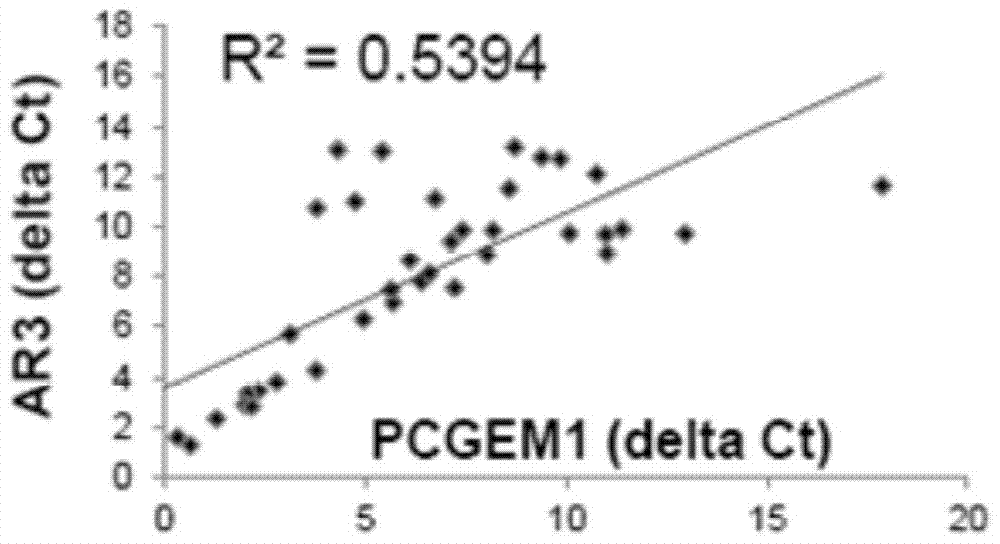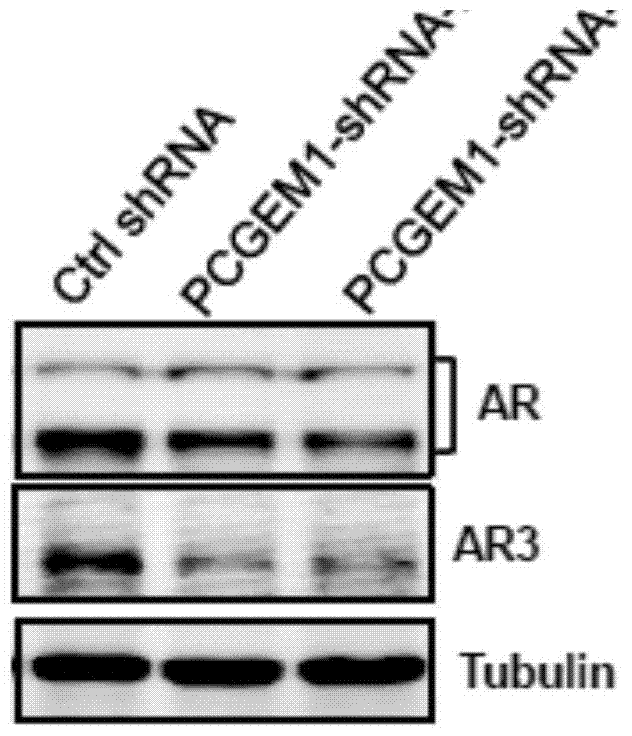A modified lna oligonucleotide targeting lncRNAs for anti-AR-related tumor castration recurrence
A technology of oligonucleotides and nucleotides, applied in the direction of antineoplastic drugs, DNA/RNA fragments, recombinant DNA technology, etc., to achieve good specificity, inhibit tumor growth, and not easy to degrade
- Summary
- Abstract
- Description
- Claims
- Application Information
AI Technical Summary
Problems solved by technology
Method used
Image
Examples
Embodiment 1
[0047] Example 1 Synthesis of lncRNA PCGEM1-LNA oligonucleotides
[0048] The effect of an LNA oligonucleotide on the expression of a target nucleic acid can be detected in any of a variety of cell types, provided that the target nucleic acid is present at measurable levels, the target is expressed endogenously, or is encoded by the Transient or stable transfection expression of the nucleic acid of the nucleic acid.
[0049] The synthetic lncRNA PCGEM1-LNA oligonucleotide sequence is as follows:
[0050] PCGEM1-LNA-1: T+T+T+TCCAAAGGG+T+CCGCTGTCCCTG+G+A+G (SEQ ID NO. 5);
[0051] PCGEM1-LNA-2: A+T+T+CCCCTCAGA+A+ATCTCAGGGCTT+G+T+C (SEQ ID NO. 6).
[0052] Wherein + is selected from any one of β-D-oxygen-LNA nucleotide analogues.
[0053] The sequences of four GAS5-LNA oligonucleotides are as follows:
[0054] a) T G T G T A TCCAAAGGG T T A CCGCTGTCCCTG T G T A A G (SEQ ID NO. 1);
[0055] b) T G T G T A TCCAAAGGG A T T CCGCTGTCCCTG T G T A A G (SEQ ID NO. 2)...
Embodiment 2
[0060] Example 2 Verification of lncRNA PCGEM1 participating in castration resistance of AR-related tumors (attached figure 1 , 2 、3)
[0061] 1. Detect the expression of lncRNA PCGEM1 in prostate malignant or metastatic tumors, high-grade malignant tumors, low-grade malignant tumors and benign tumors by nucleic acid fluorescence in situ hybridization. The specific steps of nucleic acid fluorescence in situ hybridization are:
[0062] (1) Dewaxing of paraffin-embedded tissue sections of clinical prostate cancer:
[0063] 1) Xylene dewaxing 3 times, 5min each time;
[0064] 2) 100% alcohol twice, 2 minutes each time;
[0065] 3) Remove the alcohol, place the slice obliquely, mark the end section down, and air dry.
[0066] (2) Protease treatment:
[0067] 1) 40ml of proteinase K digestion solution for each staining jar, the preparation method is as follows: 40ml of 2×SSC is poured into a Facal tube, and preheated in a water bath. Add the digestive enzyme solution into th...
Embodiment 3
[0118] Example 3 In vitro analysis: lncRNA PCGEM1-LNA oligonucleotide antisense inhibition of tumor cell PCGEM1 expression (attached Figure 4 )
[0119] LNCaP or 22RV1 cells were treated with 0.3×10 6 Cell seeding. at 37°C, 5% CO 2 cultivated under conditions. The next day after inoculation, the cells were transfected with two different lncRNA PCGEM1-LNA oligonucleotides SEQ ID NO.1 and SEQ ID NO.3 (10 μg / ml) using RNA transfection reagent (2.5 μg / ml). Briefly, cells were incubated with Lipofectamine in OptiMEM for 10 min, followed by the addition of lncRNA PCGEM1-LNA oligonucleotides SEQ ID NO.1 or SEQ ID NO.3. After 12 hours, the transfection mixture was removed, cells were washed, and plated Into an appropriate growth medium, grow at 37°C for about 48 hours, and then perform fluorescence quantitative PCR analysis.
[0120] Results: For the detection results in 22RV1 cells, see Figure 4 . The detection results in LNCaP are: compared with the experimental group trans...
PUM
 Login to View More
Login to View More Abstract
Description
Claims
Application Information
 Login to View More
Login to View More - R&D Engineer
- R&D Manager
- IP Professional
- Industry Leading Data Capabilities
- Powerful AI technology
- Patent DNA Extraction
Browse by: Latest US Patents, China's latest patents, Technical Efficacy Thesaurus, Application Domain, Technology Topic, Popular Technical Reports.
© 2024 PatSnap. All rights reserved.Legal|Privacy policy|Modern Slavery Act Transparency Statement|Sitemap|About US| Contact US: help@patsnap.com










